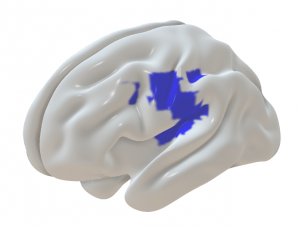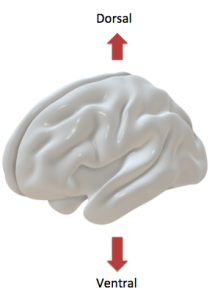Hello, readers! As I said in my previous post, this section of the website is dedicated to discussion of ongoing work in the Center for the Study of Aphasia Recovery (C-STAR).
But first, some background about our work: Here at C-STAR, our research focuses on predicting the  types of communication difficulties that may occur after an individual has a stroke. For example, some of our prior research has shown that if a person has stroke damage located in motor areas of the brain (see blue areas in the figure to the right), then that person may have trouble producing (articulating) speech sounds when speaking. Ultimately, we hope that clinicians can use this prediction information to improve diagnosis, prognosis, and treatment planning for post-stroke speech and language related difficulties.
types of communication difficulties that may occur after an individual has a stroke. For example, some of our prior research has shown that if a person has stroke damage located in motor areas of the brain (see blue areas in the figure to the right), then that person may have trouble producing (articulating) speech sounds when speaking. Ultimately, we hope that clinicians can use this prediction information to improve diagnosis, prognosis, and treatment planning for post-stroke speech and language related difficulties.
Now, on to our most recently published article: This week, Dr. Fridriksson and other C-STAR collaborators published an article in the Proceedings for the National Academy of the Sciences of the United States of America (PNAS for short). You can find a copy of the article on the PNAS website, and a summary here.
 A concept we discuss in this article is that the brain uses two routes to process language – one route for producing/articulating speech (a dorsal
A concept we discuss in this article is that the brain uses two routes to process language – one route for producing/articulating speech (a dorsal
route), and another for comprehending it (a ventral route). The figure to the left shows the general location of the dorsal and ventral areas, and more details can be found in the full article. Using a large number of speech and language tests and brain imaging data from 138 participants, this study provided more conclusive information about where these processing routes are located and the types of language processes that occur in each route. More specifically, we found that the dorsal route is responsible for the motor aspects of speech (e.g., sound selection and motoric processes for articulating speech), and the ventral route is responsible for understanding the meaning of words, helping us comprehend words and sentences.
Importantly, we believe that this study will help us work towards understanding how each of these routes work together for communication, and how we can maximize recovery to compensate for damage to one (or both) of the routes when an individual has stroke-induced aphasia.